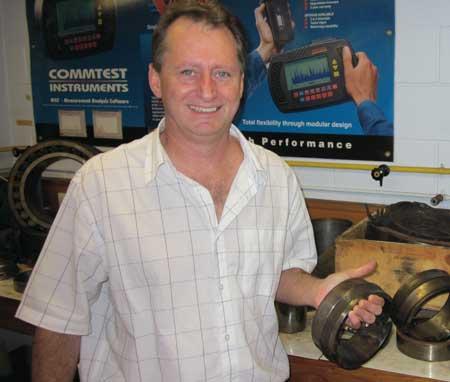|
MAKING vibration analysis (VA) easy to understand is perhaps the greatest strength of Clyde Volpe, one of two world-class VA trainers associated with the seminar programme at Manukau Institute of Technology’s Maintenance and Reliability Centre. This is the firm belief of senior lecturer Larry Wiechern.
“We are very fortunate to have the support of, in my opinion, the best vibration analysis trainers in the world in Clyde Volpe and Jason Tranter. There’re few vibration experts in the world with the ability to transfer information to reliability engineers keen to learn this technology, in such an exciting and interesting way.”
DEMM Engineering & Manufacturing magazine put five questions to Volpe to dispel some of the misunderstanding around vibration analysis:
DEMM: What are some of the myths and misconceptions surrounding the application of vibration analysis in industry?
CV: The common one is that VA can improve reliability – it cannot. Simply put, if you go to a doctor and he measures your heart, you do not live longer. If he finds a big problem while measuring your heart, this still does not make you live longer. Similarly, in the machine world taking vibration readings from a machine does not improve its reliability. Finding a bearing problem using vibration also does not improve its reliability. Operating in this mode is simply performing ‘condition monitoring’ and it is a well accepted fact that condition monitoring does not improve reliability.
The same goes for oil analysis – taking oil samples does not improve reliability. Finding contamination in the oil also does not improve reliability.
DEMM: How important is the application of vibration analysis in a reliability and maintenance program?
CV: Vibration is vital in the improvement of reliability. In the words of the great Art Crawford: “Vibration is the single most informative parameter that tells you about machine condition”. However, simply knowing condition is not enough, what are you going to do about it is where the results lie. Reliability engineers are often hired and then given the responsibility of improving reliability – but they are given a computer to do this. It ain’t gonna work! Mechanical people are given tools to do their work; electrical people are given tools to do their work; however, reliability engineers are given a computer. Good luck.
We need to empower the reliability engineer with tools to do his job and the best tool for this is vibration analysis. If he can understand the data collected by the vibration guys and then really make changes, then improved reliability will be the result. We all know that the one thing production wants is availability – well the only way we can increase availability is through reliability, because reliability drives availability.
DEMM: What anecdotal evidence can you provide that shows where VA could have prevented costly repairs and downtime?
CV: I could go on for a thousand pages with evidence of this and still only just get started. One that springs to mind is a large steel mill that heard some strange noises coming from a kiln gearbox drive. The vibration levels had hardly increased though; data was looked at in the time domain and impacts were noted. These were very small impacts that hardly raised vibration levels. Impacts are never good though (a punch on the nose, no matter how light, is never enjoyed) and the gearbox was ordered to be removed. A broken tooth was found. Had this gearbox failed, the lost production, downtime etc would have been in the millions.
DEMM: What are the key messages you’re currently teaching your students about VA and its application?
• Solve the cause. not the problem. Vibration analysis almost always shows the cause.
• Don’t just find a problem, figure out what has to CHANGE in order for the problem to be resolved. Make sure these changes are implemented.
• Focus on problems; only about five percent of your machines will have problems. These machines take up the majority of your resources – solve these problems and you free your resources up to do important required maintenance work.
DEMM: What other VA-related observations can you share?
One very simple RPI (Reliability Performance Indicator) is to take all your vibration levels; place PVI (Plant Vibration Index) numbers on all measurement points on site. Then divide this level by the number of points measured – you’ll get a number, let’s say 7mm/sec rms. The number is important; however do this every three months. If the number is staying the same then it is obvious that you have made no changes or they are not working. It will take a change to make this value go down. If you implement precision balancing, precision alignment, fix baseplates, eliminate resonances, fix soft foot conditions, then this value will reduce. The objective should be to reduce this value by ten percent per annum on the previous year’s value – why? Well, because the velocity value is proportional to the fatigue on the machine. If you reduce the plant vibration velocity reading then you are reducing fatigue across the site – and that will improve reliability, even if it is unseen.
|
Contact: larry.wiechern@manukau.ac.nz
|






